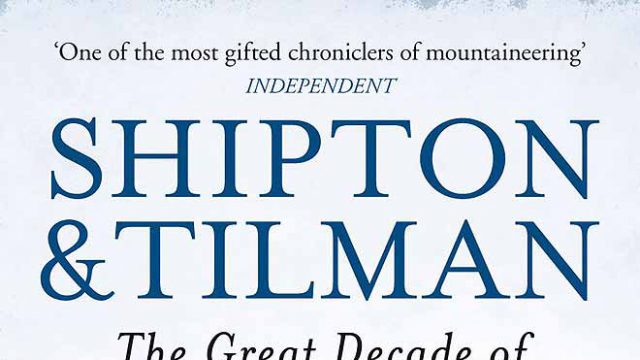Eric Shipton and Bill Tilman, two of the most intrepid and celÂebrated mountain explorers ever, are no strangers to mountaineers and people who love the Himalayas. But Jim Perrin’s masterful new biogÂraphy of these two men — partÂners, friends and irreverent dreamers — and their amazing run together, hits new highs of literary excellence. Set in the decade leading up to World War II—the ‘great decade’ of the title — the book is as much an account of the times when mountain exploration had reached its peak as a story of the pivotal role played by these two. Shipton and Tilman were the first to place the sport of mountaineering in a larger context – the urge to see the physical world in its beauty and ferocity, without a screen of ‘civilisation’ insulatÂing them.
Their method of doing so was simple, and revolutionÂary: pare the expedition back to its basics, do away with the gargantuan bandobust, including armies of porters; move lightly in a small, symÂpathetic group; and live off the land. That they managed to do this in an age when the idealisation of national pride and a militaristic approach to mountaineering was at its height is even more remarkable. The two brought about this paradigm shift not only through their successes, but also through the written word. Masterful writers of great feel and humour, they helped elevate expedition writing to the status of profound travel writing.
For the uninitiated, here are the broad outlines. Eric Shipton and Bill Tilman, born a decade apart, and followÂing two very different routes to mountaineering, met in colonial Kenya in 1929, and, in the following decade, went on to accomplish some breathtaking exploratory mountaineering ever seen, before or since. Among their many feats, their legend rests on one five-month-long season on a shoe-string budget in 1934, when they became the first human beings to find their way into the hithÂerto impassable Nanda Devi sanctuary, made the first ever crossings of the Alaknanda-Mandakini, and Alaknanda-Bhagirathi watersheds, and then returned to the sanctuÂary to do a preliminary survey of the basin, before exiting through an entirely different route. In this, they were aided by three great Sherpa companions, who went on to became legends themselves. Separately or together, the two were involved in the climbing of Kamet, of Nanda Devi, three Everest expediÂtions and one reconnaissance mission, as well as two intrepÂid surveying expeditions into the Karakoram that finally sorted out the tangled geograÂphy of this vast mountainous terrain, before the war interÂvened and brought to a close a great decade of firsts.
Although both went on to achieve great things in the post-war years, with Shipton exploring the Andean ranges of Patagonia and Tilman accomplishing some amazÂing climbs and explorations in Nepal before turning to deep sea sailing, the one decade they spent together ended up defining their lives and changing the course of mountaineering. Jim PerÂrin, a rock climber himself, is a fine writer, a two-time winner of the prestigious Boardman-Tasker Award for mountaineering literature, and a fan of Shipton and Tilman. With close personal contact with Tilman as well as their families, and armed with reams of letters, expedition notebooks as well as the two protagonists’ comÂbined output of 14 mountain travelogues, he creates a comÂpelling narrative of the two men and their vastly different provenance and motives that led them to form such a harmonious team. Their eloquence in writing — ShipÂton’s Nanda Devi is widely considered the greatest mountain travel book ever written — marked them out from any of their mountainÂeering contemporaries.
Perrin correctly searches for the origin of their authoriÂal voice in Tilman’s shattering experiences during the Great War, and in Shipton’s carefree childhood peregrinations in the idyllic natural setting of Wiltshire. So while Tilman’s much-caricatured voice — as ‘homaged’ in the satire The Ascent of Rum-Doodle — was understated, sardonic and self-deprecating, Shipton’s was dreamily romantic, and mischievously witty.
It’s impossible to overÂstate the importance of this book, especially to an Indian mountaineering culture that is ironically still stuck in the very militaristic rut that these two did so much to debunk. Modern mountaineering, or indeed travel writing, would have been very different without these gentlemen.




